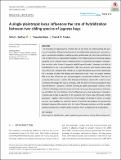A single pleiotropic locus influences the rate of hybridization between two sibling species of Lygaeus bugs
Abstract
The evolution of reproductive isolation lies at the heart of understanding the process of speciation. Of particular interest is the relationship between pre‐ and postzygotic reproductive isolation, and the genetic architecture of traits that contribute to one or both forms of reproductive isolation. The sibling species of seed bug Lygaeus equestris and L. simulans show a classic pattern of asymmetric prezygotic reproductive isolation, with female L. equestris hybridizing with male L. simulans, but with no hybridization in the reciprocal direction. We have recently described a mutant pale color form of L. simulans, that inherits as a single Mendelian locus and is pleiotropic for a number of other life history and behavioral traits. Here, we tested whether this locus also influences pre‐ and postzygotic reproductive isolation. Two sets of experimental crosses revealed that behavioral isolation varied with mutant versus wild‐type phenotype for male L. simulans, with the pale form less successful at mating with female L. equestris. In terms of trying to assess postzygotic isolation, levels of hybrid offspring production were uniformly low across the experiments. However, we did obtain, for the first time, hybrid offspring from a pairing between a female L. simulans and a male L. equestris. In this instance, the female was of the pale mutant genotype. Together with evidence for heterozygote advantage in terms of nymph survival, we consider our results in terms of possible mechanisms of reproductive isolation between this species pair, the role of the pale mutation, and the possible genetic architectures underlying the mutation, from a single gene to a supergene.
Citation
Balfour , V L , Black , D & Shuker , D M 2020 , ' A single pleiotropic locus influences the rate of hybridization between two sibling species of Lygaeus bugs ' , Ecology and Evolution , vol. 10 , no. 21 , pp. 12224-12232 . https://doi.org/10.1002/ece3.6853
Publication
Ecology and Evolution
Status
Peer reviewed
ISSN
2045-7758Type
Journal article
Description
Funding: VLB is funded by a University of St Andrews PhD Apprenticeship and DB is funded by the Laidlaw Scholars Programme.Collections
Items in the St Andrews Research Repository are protected by copyright, with all rights reserved, unless otherwise indicated.

